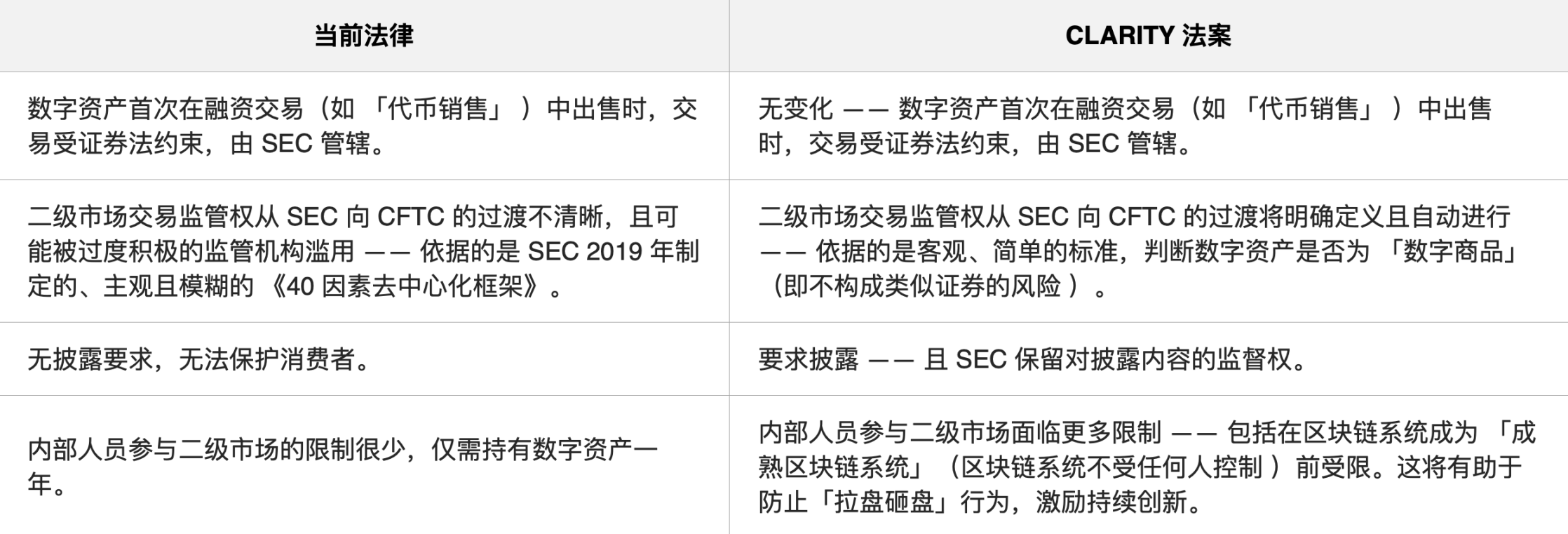a16z: Does the 'CLARITY Act' Usher in a 'Golden Age' of Crypto Compliance Innovation?
Original author: Miles Jennings, Head of Policy and General Counsel at a16z crypto
Original compilation: Luffy, Foresight News
The U.S. House of Representatives recently advanced a significant new 'market structure' bill with overwhelming bipartisan support (294 votes in favor, 134 against, with 78 Democrats supporting). The bill, known as the Digital Asset Market CLARITY Act (House Bill 3633), aims to establish a clear regulatory framework for the digital asset market. The bill has now moved to the Senate for consideration, where the Senate is drafting its own version of market structure legislation, with the CLARITY Act serving as a reference.
If passed, this bill would set clear 'rules of the game' for blockchain systems, ending years of uncertainty that stifled innovation, harmed consumers, and favored opaque operators over entrepreneurs striving for transparency. Much like the 1933 Securities Act established investor protections and spurred a century of capital formation in the U.S., the CLARITY Act has the potential to be a landmark law of its era.
When our legal framework can both foster innovation and protect consumers, the U.S. can lead the way, and the world can benefit. The CLARITY Act presents such an opportunity. Although this legislation builds on the bipartisan groundwork of last year's Financial Innovation and Technology for the 21st Century Act (FIT21), it improves upon it in several key ways, as outlined below: what entrepreneurs need to know, and why this bill is crucial for aligning innovation, consumer protection, and U.S. national security.
Coupled with the recently signed GENIUS Act (whose relevance will be detailed later), the need for broader market structure legislation has become even more urgent.
Why It Matters: The Big Picture
Despite over a decade of development in the crypto industry, the U.S. has yet to establish a comprehensive regulatory framework. However, cryptocurrency is no longer just a trend within the tech community; it has become infrastructure: blockchain systems now underpin payment systems (including via stablecoins), cloud infrastructure, digital markets, and more.
Yet, these protocols and applications have been built in the absence of clear rules. The result? Legitimate entrepreneurs face regulatory unpredictability, while speculators exploit legal ambiguities for profit. The CLARITY Act aims to reverse this situation.
By providing projects with a transparent compliance path and ensuring regulators have more effective tools to oversee actual risks, the CLARITY Act (alongside the new stablecoin bill, the GENIUS Act) will bring the already substantial crypto industry out of the shadows and into the regulated economy. This new legislation creates a framework for responsible innovation, much like the foundational laws of the 20th century that helped public markets flourish and protected consumers.
Beyond offering a clear compliance path, the bill also establishes clearer rules, giving entrepreneurs legal certainty to innovate confidently and operate domestically. This will ultimately reduce the pressure on legitimate entrepreneurs to move their operations overseas.
This legal clarity will open the door to the next generation of decentralized infrastructure, financial instruments, and user-owned applications, all built in the U.S. Ensuring that blockchain systems are developed in the U.S. will also safeguard global digital and financial infrastructure from reliance on, for example, blockchain systems created and controlled by China, while ensuring U.S. regulatory standards apply to core financial infrastructure now used outside the crypto sphere.
'Control-based' Maturity Framework, allowing blockchain projects to launch digital commodities and enter public markets without undue regulatory burdens or uncertainty.
Register with the Commodity Futures Trading Commission (CFTC);
Comply with compliance standards similar to those for traditional financial institutions.
These requirements enhance transparency in core market infrastructure, help prevent fraud and abuse, and build consumer trust. They also fill current regulatory gaps—previously, companies like FTX could operate unchecked in U.S. markets.
Mandate that digital commodity issuers fulfill compulsory disclosure obligations, ensuring retail participants have access to essential, important information;
Restrict insider trading, curbing early stakeholders from exploiting information asymmetry at users' expense.
These measures also provide a clearer roadmap for entrepreneurs building decentralized blockchain systems, fostering innovation.
How Does the 'Control-based' Maturity Framework for Blockchain Systems Work?
Unlike the traditional decentralization test based on 'efforts' established by the SEC in 2019, the CLARITY Act's maturity framework adopts clear, objective, and easily measurable standards.
These standards focus on who controls the underlying blockchain system and its associated digital commodities. This aligns more closely with other regulatory regimes (such as money transmission) and eliminates perverse incentives that discourage developers from continuing development for fear of being deemed centralized. More importantly, this approach will support legitimate developers in growing and continuing their projects (rather than abandoning them), while making it harder for bad actors to exploit legal ambiguities, including engaging in 'performative decentralization' (rather than actual decentralization).
Specifically, the bill's framework incentivizes decentralization and protects consumers by:
Imposing more oversight and stringent regulatory burdens during the formation stage of a blockchain system (when centralized control exists), when the risks associated with the system's native digital assets most resemble securities;
Reducing regulatory requirements as projects mature (with no centralized control, risks diminish and resemble commodities more).
Like previous legislative efforts to transition 'from centralized to decentralized' (compare the differences with FIT21 below), regulatory obligations for projects within the 'maturity' spectrum include:
Mandatory disclosures: to increase transparency;
Sales restrictions on insiders: to protect consumers in early stages, preventing insiders (such as related entrepreneurs and investors) from profiting from asymmetric information unknown to other consumers.
But unlike FIT21, the CLARITY Act lists seven objective, measurable criteria to determine when a specific blockchain system is no longer controlled by an individual or a collectively managed group (such as a foundation), and thus its native digital assets no longer pose securities-like risks. Because this approach centers on eliminating control, it both protects consumer investors and unleashes the full potential of blockchain technology. Moreover, by using measurable standards, the CLARITY Act provides a framework that is easier for regulators to apply and for developers to follow.
In short, this new framework represents a significant improvement over traditional regulatory frameworks, as securities laws were not designed for assets like blockchain systems, whose risk profiles can shift from securities-like to commodity-like. This new framework has also garnered broad industry support.
Launch and sell their native tokens, processes that were previously high-risk and unclear;
Adopt decentralized governance without fear of being classified as centralized;
Offer self-custody services, as many projects have already done; now, with this bill, individuals will have a 'right to self-custody.'
CLARITY levels the playing field for DeFi projects. It also paves the way for integrating DeFi's advantages into the broader financial system, unlocking its true potential for a wider consumer base.
However, the CLARITY Act is not without its flaws. It focuses solely on digital commodities, leaving out other regulated digital assets like tokenized securities and derivatives. Moreover, while the CLARITY Act exempts DeFi systems from federal intermediary rules, it does not preempt state regulations, meaning the DeFi industry remains vulnerable to inconsistent or overreaching state policies. These gaps should be addressed in the Senate, future legislation, or through coordinated regulatory guidance (such as rulemaking by the SEC and CFTC).
The industry currently lacks regulation: some may argue that no regulation is better than bad regulation, but the current lack of clarity benefits bad actors and speculators who exploit uncertainty to the detriment of consumers (not to mention regulators' unchecked overreach). FTX is a prime example of these issues, harming not just the industry but thousands of consumers. Without timely action, we leave the door open for more bad actors like FTX's former CEO.
The industry lacks transparency: without mandatory disclosures and listing standards, consumers often fall victim to scams and fraud. This lack of transparency fosters a 'casino' culture, breeding purely speculative products like meme coins.
The industry lacks protections: without clear boundaries on federal agencies' regulatory powers, blockchain projects (especially DeFi projects) remain at risk of regulatory overreach, as seen repeatedly in previous administrations.
The industry lacks standards: without standards around decentralization/control, consumers face unknown risks when using blockchain systems. For example, they may believe their assets (including stablecoins) are secure. But if these blockchain systems are controlled by a single entity (which could shut them down at will), the assets may not be safe. As all industries mature, establishing standards becomes increasingly common.
Enhances transparency: plugs loopholes in FIT21 (which could allow certain traditional projects to circumvent disclosure requirements). The CLARITY Act provides a framework for applying disclosure obligations to still-active traditional projects.
Strengthens consumer protections: makes it harder for insiders to profit from information asymmetry. For example, the CLARITY Act strictly limits project insiders from selling assets before the project matures (i.e., while they still control it).
More reasonable maturity framework: adopts a control-based decentralization test, significantly improving upon FIT21's vague approach. This framework is also more precise, as the CLARITY Act proposes seven objective, measurable criteria for determining a blockchain system's maturity.
Improves regulatory oversight: gives regulators greater flexibility, helping ensure the regulatory framework evolves and expands as the industry matures.
How Does the CLARITY Act Relate to the Recently Passed GENIUS Act?
The newly passed GENIUS Act is a critical step in modernizing the financial system. The House made history by passing this significant legislation with overwhelming bipartisan support (308 votes in favor, 122 against, with 102 Democrats supporting). However, this new legislation on stablecoins greatly increases the need for broader market structure legislation like the CLARITY Act.
Why? Because the GENIUS Act will accelerate stablecoin adoption, thereby driving more financial activity onto blockchains, increasing reliance on blockchains for a wide range of payments and commercial activities. This trend is already underway, as ubiquitous payment processors, traditional financial institutions, established payment networks, and others increasingly embrace and adopt stablecoins.
But the current stablecoin legislation does not regulate the blockchains on which all these assets rely, nor does it require these 'channels' to be secure, decentralized, or transparently governed. This gap exposes consumers and the broader economy to new systemic risks.
With the GENIUS Act signed into law, the need for the CLARITY Act has become even more urgent.
The CLARITY Act provides the necessary standards and oversight to ensure that the infrastructure underpinning stablecoins (the underlying blockchains, protocols, and other tools) meets safety, transparency, and control standards. Its objective, measurable requirements for defining mature blockchain systems also give entrepreneurs clearer guidance on how to meet these standards.
Without these complementary protections, stablecoin adoption could accelerate the use of unregulated, opaque, or even hostile infrastructure. By passing the CLARITY Act, we can ensure stablecoins operate on secure networks, further protecting consumers, reducing financial risks, and solidifying the dollar's strength and leadership in the next-generation financial system.
What Happens Next?
With the CLARITY Act passed in the U.S. House of Representatives, the bill will now move to the Senate. The Senate Banking and Agriculture Committees are likely to review the bill,
amend it through their respective processes, and then submit it to the full Senate for a vote.
However, it's more likely that a bipartisan group of senators will introduce a separate Senate version of a cryptocurrency market structure bill, which may resemble the CLARITY Act in many ways. The Senate Banking and Agriculture Committees would then review this bill through their own processes, and if approved, send it to the full Senate for a vote.
If both chambers of Congress pass their respective bills, the House and Senate will need to reconcile any differences, either through informal negotiations or a more formal conference committee, before each chamber votes on the final compromise version.
When might all this happen? Key leaders in the House and Senate have set a goal of sending a market structure bill to the president's desk by the end of September.

